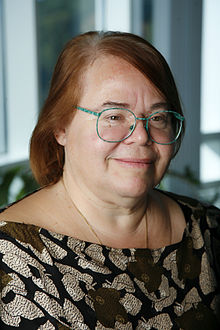Eve Marder

Eve Marder is an American neuroscientist known for her work on neural circuits in the lobster stomatogastric-ganglion (STG) system. She discovered that circuits are not “hard-wired” to produce a single output or behavior, but can be reconfigured by neurotransmitters to produce many outputs and behaviors while still maintaining the integrity of the circuit. This work changed the way scientists view the structure and function of circuits in the brain and is thought to be a general concept that can be applied to humans.
Her work on the 30 neurons comprising the lobster STG system has produced many notable findings. She found that circuits can be modulated by many neuromodulators, not just neurotransmitters. She pioneered work on plasticity and homeostasis, revealing more about how the brain can change during learning and development yet remain structurally stable. Her recent work examining network variability between healthy individuals shows that a variety of network parameters can produce the same behavioral outcome, challenging a long-standing goal in theoretical neuroscience to model 'ideal' neurons.[1]
With Larry Abbott, she also developed the dynamic clamp method, which enables an experimenter to induce mathematically modeled conductances into living neurons to view the output of theoretical circuits.[2]
She received her B.A. at Brandeis University and Ph.D. at University of California, San Diego. Her doctoral work on the role of acetylcholine in the lobster STG system led to a single-author Nature paper.[3] She completed her postdoctoral training at the University of Oregon in Eugene and the École Normale Supérieure in Paris, France. She currently serves as the Victor and Gwendolyn Beinfield Professor of Neuroscience at Brandeis University in Waltham, Massachusetts, where, in 1990, she established one of the very first undergraduate neuroscience programs in the United States.[4] She is a member of the American Academy of Arts and Sciences, United States National Academy of Sciences, serves on the National Institutes of Health working group for the BRAIN Initiative, and is a former president of the Society for Neuroscience.[5]
She is a Deputy Editor at eLife.[6] She had an early interest in politics and often writes about science, politics, and society.[7]
Awards
- Kavli Prize in Neuroscience (2016)
- Gruber Award in Neuroscience (2013)
- Member Institute of Medicine (2013)
- George A. Miller Prize, Cognitive Neuroscience Society (2012)
- Karl Spenser Lashley Prize, American Philosophical Society (2012)
- Honorary Doctor of Science, Bowdoin College (2010)
- Fellow, Biophysical Society (2008)
- Member, National Academy of Sciences (2007)
- President, Society for Neuroscience (2007)
- President-Elect, Society for Neuroscience (2006–2007)
- Gerard Prize, Society for Neuroscience (2005)
- Trustee of the Grass Foundation (2002–2005)
- Women in Neuroscience Mika Salpeter Lifetime Achievement Award (2002–2003)
- Fellow, American Academy of Arts and Sciences (2001–2001)
- MERIT (Method to Extend Research in Time) Award, National Institutes of Health (1995–2000)
- McKnight Endowment fund for Neuroscience Investigator Award (1994)
- Jacob Javits Neuroscience Investigator Award, National Advisory Neurological and Communicative Disorders and Stroke Council (1987–1994)
References
- ^ Ganguli, Ishani (31 October 2007). "Neuroscience: A gut feeling". Nature (450): 21–23. doi:10.1038/450021a. Retrieved 8 March 2015.
- ^ Gorman, James (10 November 2014). "New York Times". Learning How Little We Know About the Brain. Retrieved 8 March 2015.
- ^ Marder, Eve (Oct 25, 1974). "Acetylcholine as an excitatory neuromuscular transmitter in the stomatogastric system of the lobster". Nature. 251 (5477): 730–1. doi:10.1038/251730a0. PMID 4154406.
- ^ "Society for Neuroscience". www.sfn.org. Retrieved 2016-08-17.
- ^ "Brandeis Life Sciences Faculty Bio". Retrieved 8 March 2015.
- ^ "eLife welcomes new Deputy Editor". Retrieved 2016-08-17.
- ^ "Communicating the latest advances in life science and biomedicine". eLife. Retrieved 2015-09-27.
